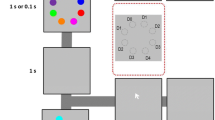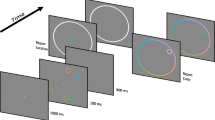Abstract
A visual object can be conceived of as comprising a number of features bound together by their joint spatial location. We investigate the question of whether the spatial location is automatically bound to the features or whether the two are separable, using a previously developed paradigm whereby memory is disrupted by a visual suffix. Participants were shown a sample array of four colored shapes, followed by a postcue indicating the target for recall. On randomly intermixed trials, a to-be-ignored suffix array consisting of two different colored shapes was presented between the sample and the postcue. In a random half of suffix trials, one of the suffix items overlaid the location of the target. If location was automatically encoded, one might expect the colocation of target and suffix to differentially impair performance. We carried out three experiments, cuing for recall by spatial location (Experiment 1), color or shape (Experiment 2), or both randomly intermixed (Experiment 3). All three studies showed clear suffix effects, but the colocation of target and suffix was differentially disruptive only when a spatial cue was used. The results suggest that purely visual shape–color binding can be retained and accessed without requiring information about spatial location, even when task demands encourage the encoding of location, consistent with the idea of an abstract and flexible visual working memory system.




Similar content being viewed by others
References
Allen, R. J., Baddeley, A. D., & Hitch, G. J. (2006). Is the binding of visual features in working memory resource-demanding? Journal of Experimental Psychology: General, 135, 298–313.
Allen, R. J., Baddeley, A. D., & Hitch, G. J. (2014). Evidence for two attentional components in visual working memory. Journal of Experimental Psychology: Learning, Memory, & Cognition. doi:10.1037/xlm0000002. Advance online publication.
Allen, R. J., Hitch, G. J., Mate, J., & Baddeley, A. D. (2012). Feature binding and attention in working memory: A resolution of previous contradictory findings. The Quarterly Journal of Experimental Psychology, 65(12), 2369–2383.
Baddeley, A. D. (2000). The episodic buffer: A new component of working memory? Trends in Cognitive Sciences, 4(11), 417–423.
Baddeley, A. D., Allen, R. J., & Hitch, G. J. (2011). Binding in visual working memory: The role of the episodic buffer. Neuropsychologia, 49, 1393–1400.
Brown, L. A., & Brockmole, J. R. (2010). The role of attention in binding visual features in working memory: Evidence from cognitive ageing. The Quarterly Journal of Experimental Psychology, 63, 2067–2079.
Darling, S., Della Sala, S., & Logie, R. H. (2009). Dissociation between appearance and location within visuo-spatial working memory. The Quarterly Journal of Experimental Psychology, 62(3), 417–425.
Fiacconi, C. M., & Milliken, B. (2012). Contingency blindness: Location-identity binding mismatches obscure awareness of contingencies and produce profound interference in visual working memory. Memory & Cognition, 40, 932–945.
Fiacconi, C. M., & Milliken, B. (2013). Visual memory for feature bindings: The disruptive effect of responding to new perceptual input. The Quarterly Journal of Experimental Psychology. doi:10.1080/17470218.2012.753925
Holm, S. (1979). A simple sequentially rejective multiple test procedure. Scandinavian Journal of Statistics, 6(2), 65–70.
Hu, Y., Hitch, G.J., Baddeley, A.D., Zhang, M., & Allen, R.J. (in press). Executive and perceptual attention play different roles in visual working memory: Evidence from suffix and strategy effects. Journal of Experimental Psychology: Human Perception & Performance.
Huang, L. (2010). What is the unit of visual attention? Object for selection, but Boolean map for access. Journal of Experimental Psychology: General, 139(1), 162–179.
Jiang, Y., Olson, I. R., & Chun, M. M. (2000). Organization of visual short-term memory. Journal of Experimental Psychology: Learning, Memory, and Cognition, 26(3), 683–702.
Kahneman, D., Treisman, A., & Gibbs, B. J. (1992). The reviewing of object files: Object-specific integration of information. Cognitive Psychology, 24, 175–219.
Karlsen, P. J., Allen, R. J., Baddeley, A. D., & Hitch, G. J. (2010). Binding across space and time in visual working memory. Memory and Cognition, 38, 292–303.
Logie, R. H. (1995). Visuo-spatial working memory. Hove: Lawrence Erlbaum Associates.
Logie, R. H., Brockmole, J. R., & Jaswal, S. (2011). Feature binding in visual short-term memory is unaffected by task-irrelevant changes of location, shape, and color. Memory & Cognition, 39, 24–36.
Pertzov, Y. & Husain, M. (2013). The privileged role of location in visual working memory. Attention Perception & Psychophysics.
Shomstein, S., & Behrmann, M. (2008). Object-based attention: Strength of object representation and attentional guidance. Perception & Psychophysics, 70(1), 132–144.
Treisman, A., & Gelade, G. (1980). A feature-integration theory of attention. Cognitive Psychology, 12, 97–136.
Treisman, A., & Sato, S. (1990). Conjunction search revisited. Journal of Experimental Psychology: Human Perception and Performance, 16(3), 459–478.
Treisman, A., & Zhang, W. (2006). Location and binding in visual working memory. Memory & Cognition, 34(8), 1704–1719.
Ueno, T., Allen, R. J., Baddeley, A. D., Hitch, G. J., & Saito, S. (2011a). Disruption of visual feature binding in working memory. Memory & Cognition, 39, 12–23.
Ueno, T., Mate, J., Allen, R. J., Hitch, G. J., & Baddeley, A. D. (2011b). What goes through the gate? Exploring interference with visual feature binding. Neuropsychologia, 49, 1597–1604.
Wheeler, M. E., & Treisman, A. (2002). Binding in short-term visual memory. Journal of Experimental Psychology: General, 131, 48–64.
Woodman, G. F., Vogel, E. K., & Luck, S. J. (2012). Flexibility in visual working memory: Accurate change detection in the face of irrelevant variations in position. Visual Cognition, 20(1), 1–28.
Author information
Authors and Affiliations
Corresponding author
Rights and permissions
About this article
Cite this article
Allen, R.J., Castellà, J., Ueno, T. et al. What does visual suffix interference tell us about spatial location in working memory?. Mem Cogn 43, 133–142 (2015). https://doi.org/10.3758/s13421-014-0448-4
Published:
Issue Date:
DOI: https://doi.org/10.3758/s13421-014-0448-4




